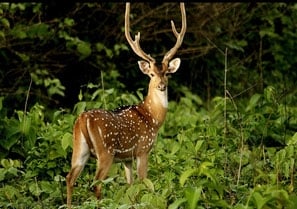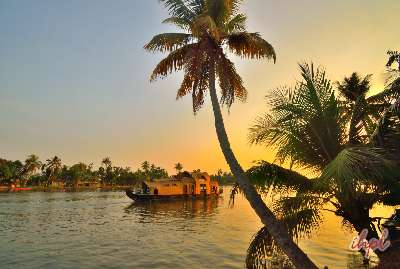The sanctuary if famous for its tigers and leopards along with the other animals and varied variety of birds which one can enjoy during the holidays.
Uncommon and endangered species of both flora and fauna can be found in Kerala’s second-largest wildlife sanctuary, Wayanad. It is encircled by the protected areas of Bandipur and Nagarhole in Karnataka and Mudumalai in Tamil Nadu. The wildlife sanctuary was established in 1973 and is a crucial component of the Nilgiri Biosphere Reserve, India’s first 14 biospheres. The sanctuary is divided into Upper Wayanad and Lower Wayanad, with a total area of 345 square kilometers. Bamboo and eucalyptus trees are both growing there. The Wayanad Wildlife Division takes care of the sanctuary with its headquarters at Sultan Bathery. Wayanad Wildlife Sanctuary in Kerala offers a lot to explore for those who seek some adventure in their lives.
Jeep safari in Wayanad Wildlife Sanctuary
The two-hour jeep safari offered by the forest department in the jungle’s tourist zone is Wayanad’s standout ecotourism activity. You can face the wild with a driver and an experienced guide. As the jeep rattles down the forest trail, occasionally displaying breathtaking sights, you would not realize how quickly time passes. Elephant and gaur herds are familiar sights along the route, but seeing a large cat is a real treat. Jeep safaris are run in the early morning and late at night when there is a fair amount of wildlife activity in the tourist area.
Jeep safari cost and timings
Timings– 07.00 AM to 10.00 AM (40 Jeeps are allowed) | 03.00 PM to 05.00 PM (20 Jeeps are allowed)
Fee– 100 Guide fee
300 for Jeep Safari
Flora and Fauna in Wayanad Wildlife Sanctuary
You will get a beautiful view of the diverse flora and fauna as you cross the roads to Muthanga and Tholpetty. The plantations along the roadside are all lush and green, with bamboo trees, prickly ginger bushes, and other lovely trees and bushes growing there. Another remarkable feature you’ll see along the trip is paddy fields.
Flora
Most of the sanctuary area is covered in moist deciduous forests, but there are a few small sections of evergreen forests. The sanctuary’s bamboo groves and deciduous forests are among its main draws. Plantations of teak, rosewood, silver oak, and eucalyptus cover one-third of the sanctuary. The sanctuary also includes marshy areas.
- Terminatia chebula
- Kydia calycina
- Anogeissus latifolia
- Osteospermum colias
- Dalbergia latifolia
There are also numerous bushes and creepers in the area. In the forests of Wayanad, one can see woody climbers like Entada scandens and Calycopteries floribunda.
Fauna
Elephant herds and deer herds can be seen crossing roads and through woodlands in the sanctuary, among other wildlife. In addition, the cat family members, including tigers and panthers, are in the area. Visitors to the sanctuary may also see langurs, bonnet macaques, monkeys, sambar, bison, and bears. The slender loris is part of the abundant wildlife in the woodland.
The sanctuary is home to monitor lizards, pit vipers, coral, golden trees, and green whip snakes, among others. Crocodiles, a type of gecko called the termite hill gecko
- Flying lizards
- Chameleons
- Skink
- Flapshell turtles
- skinks
The sanctuary is home to 216 bird species, including peacocks, babblers, owls, black woodpeckers, cuckoos, and jungle fowls. In addition, the region is home to over 30 species of amphibians, including the bronze frog, Malabar gliding frog, elegant microhylid, red microhylid, ornate microhylid, and Ceylon kaliula.
The rivers that intersect the sanctuary are home to a wide variety of fish, including giant danio, Wayanad mystus, Malabar catopra, korhi barb, snakeheads, and Ariza labeo.
History of Wayanad Wildlife Sanctuary
In 1973, the Wayanad Wildlife Sanctuary was founded. Pazhassi Raja had resided in these jungles while he was a rebel against the British. Because the sanctuary was a part of Project Elephant, you will see several herds of elephants roaming freely through the national parks and neighboring states as you travel along the route. Visitors are only permitted to stay in the outer zone because only wardens and researchers have access to the inner zone, which is 25 kilometers wide. Wildlife can be seen in nearby areas, and the sanctuary is home to various plants and animals.
A tiger was shot and killed in 2012 by the Kerala Forest Department in the coffee plantations of the Wayanad Wildlife Sanctuary. The local political elites gave this killing high acclaim. However, after reports and concerns over the tiger stealing and murdering domestic animals, Kerala’s chief wildlife warden plans to carry out the hunt.
Best time to visit Wayanad Wildlife Sanctuary
How to Reach Wayanad Wildlife Sanctuary
All forms of transportation are excellently connected to the Wayanad Wildlife Sanctuary. Numerous express and luxury bus services connect the sanctuary to Kerala’s major cities, towns, and neighboring states. At a distance of 98 kilometers from Calicut, 216 km from Kasargod, 502 km from Trivandrum, and 286 km from Cochin. Wayanad Wildlife Sanctuary is also reachable by private taxis.
Nearby Tourist Attractions
- Seetha Devi Temple
- Kuruva Island
- Valmeekam Tribal Museum
- Begur Reserve Forest
- Thrissilery Shiva Temple
- Muneeswaran Kunnu Viewpoint
- Muneeswaran Temple
Wayanad Tour Packages
List Of Popular Wildlife Sanctuaries In South India
 Kabini Wildlife Sanctuary
Kabini Wildlife Sanctuary  B R Hills Wildlife Sanctuary
B R Hills Wildlife Sanctuary  Dandeli Wildlife Sanctuary
Dandeli Wildlife Sanctuary  Mudumalai Wildlife Sanctuary
Mudumalai Wildlife Sanctuary  Nagarjunsagar Wildlife Sanctuary
Nagarjunsagar Wildlife Sanctuary  Aralam Wildlife Sanctuary
Aralam Wildlife Sanctuary  Peechi Vazhani Wildlife Sanctuary
Peechi Vazhani Wildlife Sanctuary  Peppara Wildlife Sanctuary
Peppara Wildlife Sanctuary  Shendurni Wildlife Sanctuary
Shendurni Wildlife Sanctuary  Cauvery Wildlife Sanctuary
Cauvery Wildlife Sanctuary  Gudavi Bird Sanctuary
Gudavi Bird Sanctuary  Kolleru Lake Bird Sanctuary
Kolleru Lake Bird Sanctuary  Manjira Wildlife & Bird Sanctuary
Manjira Wildlife & Bird Sanctuary  Pakhal Wildlife Sanctuary
Pakhal Wildlife Sanctuary  Papikonda Wildlife Sanctuary
Papikonda Wildlife Sanctuary  Pocharam Forest Sanctuary
Pocharam Forest Sanctuary  Pranhita Wildlife Sanctuary
Pranhita Wildlife Sanctuary  Rollapadu Bird Sanctuary
Rollapadu Bird Sanctuary  Parambikulam Wildlife Sanctuary
Parambikulam Wildlife Sanctuary  Bhadra Wildlife Sanctuary
Bhadra Wildlife Sanctuary  Krishna Wildlife Sanctuary
Krishna Wildlife Sanctuary  Sivaram Wildlife Sanctuary
Sivaram Wildlife Sanctuary  Pulicat Sanctuary
Pulicat Sanctuary  Srilanka Malleswara Sanctuary
Srilanka Malleswara Sanctuary  Chinnar Wildlife Santuary
Chinnar Wildlife Santuary  Idukki Wildlife Sanctuary
Idukki Wildlife Sanctuary  Neyyar Wildlife Sanctuary
Neyyar Wildlife Sanctuary  Rajamala Wildlife Sanctuary
Rajamala Wildlife Sanctuary  Coringa Wildlife Sanctuary
Coringa Wildlife Sanctuary  Eturnagaram Sanctuary
Eturnagaram Sanctuary  Gundla Brahmeswara Sanctuary
Gundla Brahmeswara Sanctuary  Kaundinya Wildlife Sanctuary
Kaundinya Wildlife Sanctuary  Kawal Wildlife Sanctuary
Kawal Wildlife Sanctuary  Kinnerasani Wildlife Sanctuary
Kinnerasani Wildlife Sanctuary  Crocodile Bank Tamil Nadu
Crocodile Bank Tamil Nadu  Kalakkadu Wildlife Sanctuary
Kalakkadu Wildlife Sanctuary  Mundanthurai Wildlife Sanctuary
Mundanthurai Wildlife Sanctuary  Point Calimere Wildlife Sanctuary
Point Calimere Wildlife Sanctuary  Srivilliputhur Grizzled Squirrel Wildlife Sanctuary
Srivilliputhur Grizzled Squirrel Wildlife Sanctuary  Vallanadu Black Buck Wildlife Sanctuary
Vallanadu Black Buck Wildlife Sanctuary






